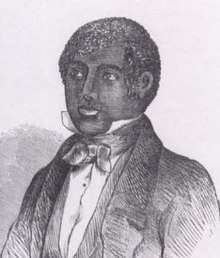Thomas Sims

Thomas Sims (born about 1834 – November 29, 1902) was an enslaved African American who escaped from slavery in Georgia at age 17 and lived for a time in Boston, Massachusetts. He was captured under the Fugitive Slave Act of 1850 and returned to Georgia. After being sold back into slavery in Mississippi, Sims escaped again and returned to Boston.
His case incited outrage among abolitionists, as was later the case with the trial of Anthony Burns.
Arrest and return

He was arrested there under the federal Fugitive Slave Law on April 4, 1851. Following a dramatic court trial, he was returned to Georgia against the strong protests of abolitionists.
The Boston Vigilance Committee, which had helped Shadrach Minkins escape the custody of U.S. marshals, was unable to rescue Sims. They planned to place mattresses under Sims's cell window so he could jump out and make his getaway in a horse and chaise, but the sheriff barred the window before they could act.[1]
The federal government sent U.S. Marines to march Sims down the streets of Boston, to be taken away on a warship and transferred back to Georgia. Sims was sold to a new owner in Mississippi, but escaped in 1863 and returned to Boston.[2]
Reactions
The "Sims Tragedy" was a cause célèbre in the Massachusetts abolitionist movement (see for instance, the references in Henry David Thoreau’s Slavery in Massachusetts) and drew sympathy from many northerners. Probably the most renowned fugitive slave case of the decade also occurred in Boston. Three years after Sims' arrest, Judge Edward G. Loring ordered the fugitive Anthony Burns back into slavery in Virginia. Another attempt was made by abolitionists as hundreds of whom poured onto the streets on various occasions in support of the fugitive. As in the case of Sims, Burns was also taken by U.S. Marines to a ship destined for Virginia, but by the time of Burns's deportation his cause had become so celebrated that 50,000 people watched federal officers take him to the wharf. Within a year, Burns was back in Boston. African Americans had raised $1,300 to pay the price being asked for him.[3]
Later years
After the Sims trial, Charles Devens, a U.S. marshal, was ordered to return Sims to Georgia. Devens had qualms about the assignment, and later tried to buy Sims's freedom, but was unsuccessful. In 1877, Devens was appointed U.S. Attorney General by President Rutherford B. Hayes. While in office, he appointed Sims to a position in the U.S. Department of Justice.[4]
See also
References
- ↑ Snodgrass, Mary Ellen (2015). The Underground Railroad: An Encyclopedia of People, Places, and Operations. Routledge. p. 485. ISBN 9781317454168.
- ↑ Stanley W. Campbell, The Slave Catchers: Enforcement of the Fugitive Slave Law, 1850-1860, University of North Carolina Press, 1970, pp. 117-121
- ↑ Campbell, The Slave Catchers , pp. 124-130
- ↑ Wright, John D. (2013). Routledge Encyclopedia of Civil War Biographies. Routledge. p. 156. ISBN 9780415878036.